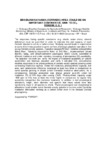Please use this identifier to cite or link to this item:
http://www.alice.cnptia.embrapa.br/alice/handle/doc/902506| Title: | Brazilian savanna (cerrado) area could be an important continental sink to CO2. |
| Authors: | RONQUIM, C. C.  |
| Affiliation: | CARLOS CESAR RONQUIM, CNPM. |
| Date Issued: | 2011 |
| Citation: | In: BRAZILIAN BIOENERGY SCIENCE AND TECHNOLOGY CONFERENCE 1., 2011, Campos do Jordão. Anais... São Paulo: FAPESP, 2011. |
| Pages: | 1 p. |
| Description: | The responses facing specific constraints (e.g. shade, water stress, mineral deficiency) must be quantified in order to estimate the real capacity of each Cerrado species to act as a carbon sinker. Studying several levels of organization at same time it was possible to point out how phenotypic plasticity operates in five young Cerrado woody species, Copaifera langsdorffii Desf, Cybistax antisyphilitica (Mart) Mart., Tabebuia chrysotricha (Mart. ex DC) Mart., Anadenanthera falcata (Benth.) Speg., and Stryphnodendron adstringens (Mart.) Coville, submitted to different irradiance and under transitory increasing of atmosphere CO2 availability. The objective this work are verify the impact of irradiance availability on carbon assimilation and biomass alocation and verify if elevated CO2 concentration modifies responses of net photosynthesis of cerrado woody species growing under contrasting irradiance regimes. Under full irradiance, photosynthetic capacity, leaf area, and carboxilation efficiency increased at least two times in comparison to same species growing in shade (under Cerradão irradiance attenuation). As a consequence, biomass production was always greater (p<0.05) under full irradiance (FI) till 570 days after sowing (DAS). Photosynthetic capacity under 1600 ppm of CO2 was at least two times higher in comparison to regular CO2 availability irrespective the irradiance treatment. In addition to leaf physiological alterations, height, stem diameter and specific leaf mass values were also significantly lower in all species in shade. These physiological and morphological alterations could enable some Cerrado woody species to survive under Cerradão irradiance attenuation working as a carbon sinker even in the densest Cerrado physiognomy. |
| Keywords: | Leaf gas exchange Irradiance Biomass partitioning |
| Type of Material: | Resumo em anais e proceedings |
| Access: | openAccess |
| Appears in Collections: | Resumo em anais de congresso (CNPM)  |
Files in This Item:
| File | Description | Size | Format | |
|---|---|---|---|---|
| RonquimRA.pdf | 11.2 kB | Adobe PDF |  View/Open |









